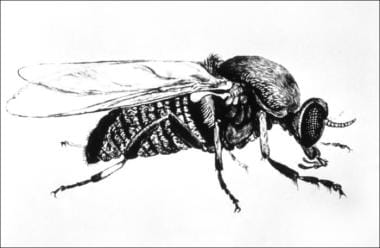Background
Onchocerciasis is an infection caused by the nematode Onchocerca volvulus. Humans acquire onchocerciasis through the bite of Simulium blackflies (see image below).
Because the fly develops and breeds in flowing water, onchocerciasis is commonly found along rivers and is sometimes referred to as river blindness.
Simulium fly (black fly).
In the human host, the adult nematodes live in subcutaneous nodules and produce microfilariae, which are found throughout the body but preferentially reside in the skin and eye. Repeated exposures to infected flies increase the number of adult worms and microfilariae in the host. Chronic cutaneous onchocerciasis (onchodermatitis) causes pruritus, a papular rash, scarring, and lichenification. Over time, affected skin may begin to sag, leading to terms such as “hanging groin.” Patchy depigmentation on the legs leads to a condition known as leopard skin. The term sowda is used to describe severe pruritus with darkening of the skin, often confined to one limb. Chronic ocular onchocerciasis may lead to sclerosing keratitis and iridocyclitis, and finally to blindness.
Onchocerciasis is endemic in Africa, Yemen, and in small foci in Central America and South America. The burden of the disease has been reduced by prevention efforts, including control of the fly vector and periodic ivermectin therapy in at-risk individuals. More recently, attention has been focused on Wolbachia organisms, which are endosymbiotic bacteria carried by adult worms and microfilariae. Treatment of Wolbachia infection has been shown to disrupt microfilariae production by the adult female nematode. Despite these efforts, onchocerciasis remains the second leading infectious cause of blindness worldwide.

